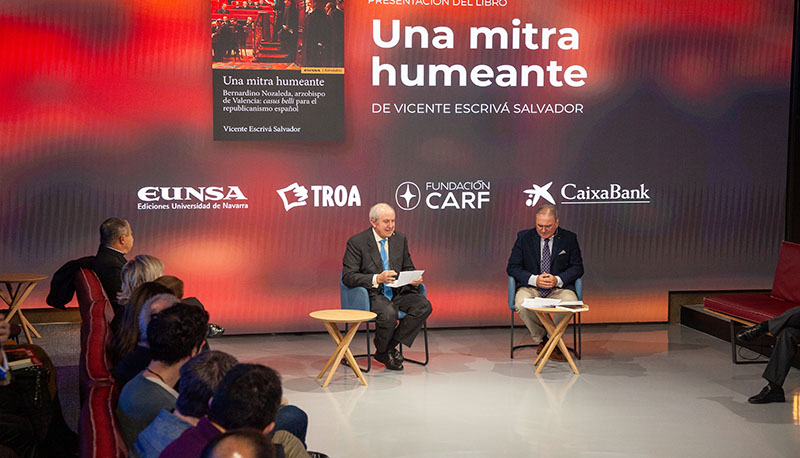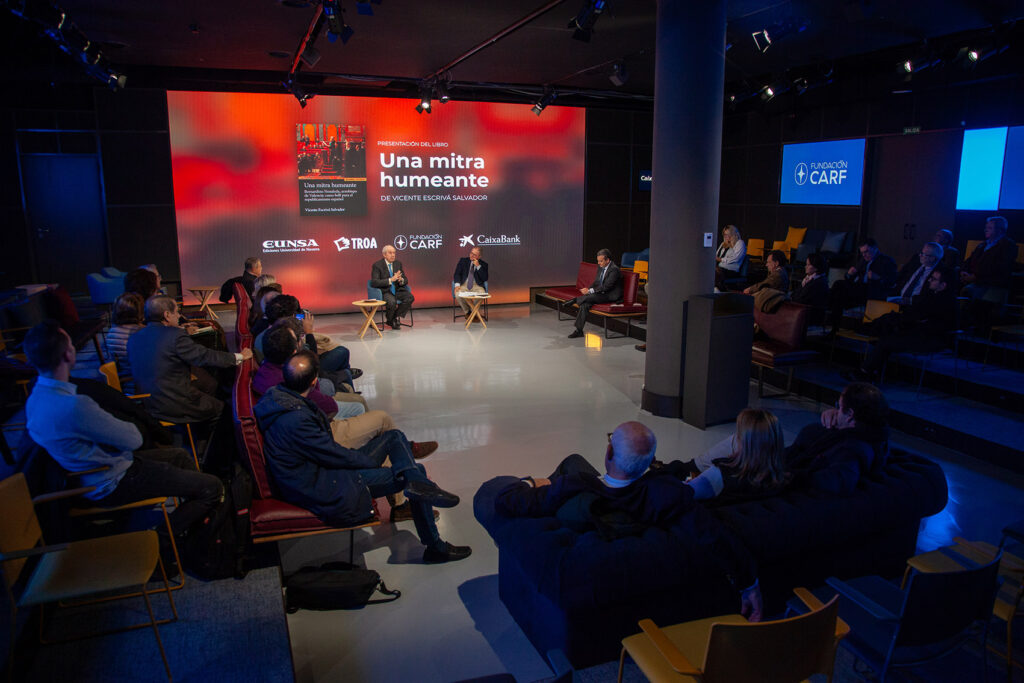
Vicente Escrivá SalvadorD. in Humanities (Contemporary History), has conducted a thorough investigation to do justice to a bishop who was never able to take possession of his mitre due to the supporters of Spanish republicanism in the early twentieth century.
The frustrated appointment of the Dominican friar Bernardino NozaledaThe last archbishop of Manila under Spanish rule, as archbishop of Valencia. Republicans and liberals lit their torches and, shouting "Death to Maura, death to Nozaleda! they inflamed their hosts so that the prelate would neither set foot on Valencian soil nor take possession of his mitre and crosier. And they succeeded.explains Vicente Escrivá in the synopsis of his book: A smoking miter. Bernardino Nozaleda, Archbishop of Valencia. Casus belli for Spanish Republicanism. (EUNSA).
Proceeds from the sale of this book will be donated by the author to the CARF Foundation. The general director of the Foundation, Luis Alberto Rosales, presented the author of this story on November 22 at CaixaBank's All in One space in Plaza de Colón, in Madrid, in the presence of His Holiness' nuncio, Bernardito Auza and Cleopaswho, as a Filipino, wanted to tell the story of the last Spanish archbishop of Manila.
It is not a religious book, nor about Nozaleda's biography. "It is a book of historical-political themes. It deals with how the instrumentalization of an ecclesiastical appointment served to try to overthrow the so-called 'Short Government' (1903-1904) of Antonio Maura by broad sectors, both of the Liberal Party (Segismundo Moret, the Count of Romanones, José Canalejas...) and of republicanism, both national (Miguel Morayta, Lerroux) and Valencian (Blasco Ibáñez, Rodrigo Soriano). The 'odium against Maura' was channeled through the 'odium' against Nozaleda," explains Vicente Escrivá.
The Disaster of '98 shocked the country, plunging it into a political, moral and cultural pessimism that would mark and give its name to a whole generation of intellectuals and writers of the time. The republicans, through a 'well-armed' press characterized by its Jacobin anticlericalism, mobilizations and rallies held throughout the length and breadth of the Peninsula, attacked the constitutional regime and everything it represented, in particular the monarchy and the Catholic Church.

"The Disaster of '98 did not overthrow the Government, nor did it give rise to a revolutionary process (as in 1830 or 1848), nor was the monarch executed, nor did he go into exile. This disaster had to find some culprits for that hecatomb that shook the country. And those were the friars, called by the anticlericalism of the time as yugo frailuno. And Bernardino Nozaleda was the last Spanish archbishop of Manila, being present there when the plaza surrendered. He was the perfect scapegoat," says the author of the book, who holds a master's degree in Modern History from the University of Valencia.
There has not been a similar case in the contemporary history of Spain: a bishop who cannot take office for political reasons. "Yes, there were some vacant sees due to various circumstances. But no bishop was prevented from taking possession of his mitre, once his appointment was agreed upon by the Vatican and the Government of the day. And even less with death threats if he dared to step on Valencian soil. In fact, Blasco Ibáñez even exhibited a pistol in the Congress of Deputies warning that if Nozaleda stepped on Valencia blood would be spilled in its streets. This is transcribed in the diary of sessions and anyone can consult it", Vicente Escrivá points out.
The author intends with this book to make known some facts that as Spaniards and also for the Valencians we should know. In addition, according to his research, Freemasonry had a role in these events. It is given the circumstance that, although the Philippines is the third country in number of Catholics, it also increases the number of Catholics in the world. the number of the faithful in the dioceses who join Masonic lodgesFor this reason, the Dicastery for the Faith has published a brief note recalling the incompatibility between Catholicism and Freemasonry.
"The Masons will embody the first manifestations of anticlericalism in liberal Spain, which will give it a radical character, unlike the British Rite Freemasonry. This meant that in time it became incompatible to be a republican and a Catholic at the same time. Freemasonry became an anti-monarchical, anti-Christian, anti-religious revolutionary force. Its cult of secrecy, its complex rituals and its symbology exerted an unquestionable influence on the liberal elites," explains the author of the book.
Bishop Nozaleda fought with the courage and zeal of a pastor against Freemasonry in the Philippines. He sent several communications to the successive governors general of the Philippines in which he denounced the maneuvers orchestrated by Freemasonry and the Katipunan (a secret revolutionary association founded by Andres Bonifacio) to prevent Catholic worship, intimidate rural parish priests and carry out all kinds of activities aimed at de-Christianizing the Filipino people. by means of heterodox printed sheets and pamphlets, in which the mysteries of Religion are attacked in a coarse style, and its ministers insulted in various ways..
The book tells how the Spanish Masons never forgave him and when he was recommended to occupy the prestigious Valentina seat, they decided to settle accounts, accusing him of being a traitor and colluding with the enemy.
Today, the most reliable historiography does not question the The role that Freemasonry played in connection with the independence of the Philippines was prominent. Perhaps it was not the determining factor, but it was one of the main contributing factors. And there are the sources to corroborate it since, as the British historian Eric Hobsbawm said: "bad history is not harmless history. It is dangerous."said Vicente Escrivá.
Nozaleda, despite defending himself in the Supreme Court for all the slander against him, (he won the trial) could not take possession of his title and never got to pastor the archdiocese of Valencia.
To avoid further political complications, Nozaleda presented his resignation on May 15, 1905 and it was immediately accepted. Pope St. Pius X, praised his gesture and named him titular archbishop of Petra, and the Dominican priest was able to teach at the Convent of St. Thomas of Avila and later at the Convent of the Rosary in Madrid, where he died as archbishop of Petra. He was senator for the Archdiocese of Valencia in the legislature of 1922-1923.
Escrivá's book also tells how he had the opportunity to visit Valencia on the occasion of the festivities held in 1923 for the canonical coronation of the Virgin of the Forsaken, without the slightest protest against his presence in the city.
Years later, the Count of Romanones himself wrote: "As the years went by, I often saw Nozaleda strolling through the most solitary fronds of the Retiro; upon discovering his haughty bearing and his white stole, I remembered those days of parliamentary tempest where he was so badly treated".
When he died in 1927, at the age of eighty-two, he was wearing the ring that Alfonso XIII gave him as a gift when he was proclaimed Archbishop of Valencia. One of the first to visit his mortuary chapel was the former military governor of the Philippines, Captain General Valeriano Weyler, accompanied by his sons.
He could not even rest in peace. Misfortune followed him to his grave. He wanted to be buried next to his beloved and venerated master, Cardinal Ceferino González, in the convent of Ocaña. At the beginning of the Spanish Civil War his tomb was desecrated, his mortal remains were lost and the convent was converted into a garage and workshop.
The book is prefaced by the Archbishop Emeritus of Valencia, Don Antonio Cañizares, who says: "The biography of the Dominican Fr. Bernardino Nozaleda Villa (San Andrés de Cueña, 1844 - Madrid, 1927), like that of other ecclesiastical figures between the 19th and 20th centuries, is a constant story of personal and pastoral self-improvement in the service of the Church.
In 1889 Leo XIII appointed him archbishop of Manila, where he carried out a great pastoral work visiting the diocese, counteracting the attacks on the Church by the anticlerical press and carrying out an important humanitarian action, especially during the siege of Manila by the American army. This delicate situation that the island was living led him to ask for his resignation, which was accepted by Rome in 1902 and, although he was proposed as archbishop of Valencia, a fierce campaign against his appointment and the unjustified accusations of having collaborated with the Americans in the loss of the Philippines, led him to resign again in 1905, and the Pope named him titular archbishop of Petra in compensation. The protests and the support of the Cardinal of Toledo, Blessed Ciriaco Maria Sancha, Archbishop of Valencia, were of no avail".
Marta SantínJournalist specializing in religious information.